-

人教版新课标PEP小学英语三年级下册Where is my ruler说课稿7篇
1、教学内容PEP Primary English BookⅡ Where’s my ruler?第一课时 A. Let’s talk. Let’s practise. C. Culture.2、教材简析本单元的核心教学内容是找东西和借东西的话题与交通工具,学生生活用品的词汇教学及六个字母(Uu Vv Ww Xx Yy Zz)的听、说、读、写。①Let’s talk. 会话学习。本课时通过寻找东西这一情境,学习句型Where is …?及掌握介词in 、on 和under的用法,让学生在模仿、学习表演的基础上达到自然交流和真实运用。②Let’s practise. 会话游戏活动,让学生在游戏中熟练运用所学问句。③Culture. 文化交流,渗透C部分中“六一”国际儿童节的文化内容,并学唱《Happy Children’s Day》。根据小学英语会话循序渐进的特点,此课作为第一课时,为整个单元教学打好基础,作好教学铺垫。同时,在整一个小学英语教学中,作为交际功能的一部分,它也是一个不可或缺的部分。
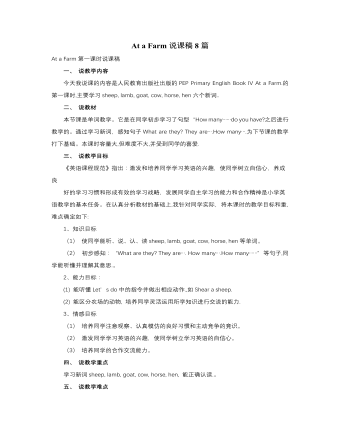
人教版新课标PEP小学英语四年级下册At a Farm说课稿8篇
一、说教材《At a Farm》是义务教育课程标准实验教科书英语(PEP)四年级下册的内容。本课要求在理解课文的基础上掌握五个动物的单词“cat, rabbit, pig, duck, dog”和两个句子“Are they ducks? No, they aren’t.”本节课是四年级下册第六单元第三课时。本单元重点学习农场上常见的牲畜和蔬菜名称以及包含名词复数的一般疑问句,而学生在学习了前两课时之后,排除了句型上的困难,而且这五个单词在以前的学习中也见到过,所以要把单词和句型的规范书写放在首位,打牢基础,还要培养学生在理解课文基础上朗读课文的能力。我确定了三个教学目标。1、能够听、说、读、写“cat, rabbit, duck, pig, dog”这五个动物单词以及句子“Are they ducks? No, they aren’t.”2、能够理解并试唱Let’s chant部分的歌谣。3、能够总结五个元音字母的发间规律。重点:掌握五个动物名词以及句型的拼写。难点:准确朗读课文和五个元音字母的发音规律。

人教版新课标PEP小学英语四年级下册What Time Is It说课稿5篇
三.说教学设计1.Warm-up用Free talk 的方式复习上一课的几个句型。For example: What’s this? // Is this a pen ?/Yes, it is./No, it isn’t.Where is your classroom?How many Ss are there in your class?……用几个How many句型引出数字,达到复习和引出新课的目的,然后sing a song 用数字歌营造良好的英语学习气氛,也为新课呈现做好铺垫。2.Presentation//PracticeA.通过把数字1----12用圆圈起来的方式做出一面钟,从而学习句型What time is it? It’s…… o’clock. 用钟更换不同的时间,让学生操练此句型。B.学生通过图片了解了ZhangPeng 的一天,从而通过单词卡学习新单词:music class, P.E. class, English class, breakfast, lunch, dinner.在单词教学中,我先让学生跟读,拼读,认读,再采用游戏,比赛的方式进一步操练巩固单词,为下一步操练句型打基础。C.在熟练的操练单词之后,结合第一步的句型,引出新句型It’s time for……让学生结合单词句型进行操练。在操练过程中吧Let’s do的内容自然地溶入。在操练Let’s do的时候可边读边做动作让学生通过了解动作了解句子的意义。

人教版新课标PEP小学英语四年级下册Is This Your Skirt说课稿5篇
出现pants , jeans 两张图片,用剪刀剪pants , jeans (动画剪刀剪的过程)pants , jeans 变成了shorts . 点击分别出现shorts的图片,接着(Shorts. They are shorts .Yes ! they are shorts)结合实物shorts,引出new 和old,引导学生描述自己带来的衣服,与let’s chant有机结合起来。(2)“Listen and guess”看口形,猜单词。设计意图:突破本课的难点shoes socks和 shorts的读音。(3)小练习:Listen and write. 活动手册P18页设计意图: 学完单词之后立刻来个小测试,把新单词融入情境对话中练习,检查学生的整体认知情况。(4)let’s chant.结合在小练习中的句型,要求学生one by one描述自己身上的衣服,引出let’s chant. 跟着课件一起唱。设计意图:通过chant,让学生在说一说中体会单数名词和is,复数名词与are 的连用。3、趣味操练课上到这里,学生可能有点累了,为了让学生的精神重新集中起来,我设计了三个游戏活动来激活学生的活动细胞。

人教版新课标PEP小学英语四年级下册It’s Warm Today说课稿10篇
活动三:猜猜天气,真实对话。本课重难点是问句Can I wear my____?句型的自然运用,如何让学生开口去问这个问题,真实情境的创设可化解这一难题。我设计了一个根据提示猜天气的游戏,由生与温度计的互动进行操作,在学生猜的过程中教授句型Can I wear my____?避免了机械式的句型问答操练,调动学生说的积极性。活动四:再编儿歌,整合句型在问句与答句教授完后,朗朗上口的儿歌让学生对新授句型有一个整体的感知,并加深句型理解,为最后学生语言的输出作好准备。活动五:自然承接,理解运用。在学生对Can I wear my____? Yes, you can. No ,you can’t.句型有了初步的感知之后,再去引导学生给别人的穿着提出建议You can wear____.并出示不同特征天气的图片让学生进一步操练,在理解运用中简单带过这一句型。3、搭建语言框架,演绎语篇创设情景,充分挖掘教材中未呈现的内容,以地图为主线,以任务为驱动,充分开展小组合作学习。

人教版新课标PEP小学英语四年级下册Our School说课稿5篇
Step 4.Homework(预计1分钟)1、做本单元B Let’s talk的活动手册配套练习2、将 设计的学校用英文介绍给爸爸妈妈(设计思路:作业 课堂教学的延伸学习的扩展活动 要求学生在熟练 本课时所学内容的基础上 将 设计的学校用英文介绍给 的父母 学生 动口、动手、动脑 发展学生运用知识的能力 ) Our School B Let’s talk Let’s play说课稿一、说教材我说课的内容是PEP小学英语四年级下学期Our school Part B的第二课时,包括Let’s talk和Let’s play两部分。1、教学内容第一单元的教学内容是围绕“School”这个主题展开的。本节课是一个对话教学,我们在前几课时中学过了一些关于学校各个教学活动场所的英语名称,在本节课,我们要将所学到的这些知识运用到对话中来,首先进行简单问答练习,进而让学生学会在真实情景中运用这些语言进行表演和交流。这也正是本课的最终所要达到的效果。
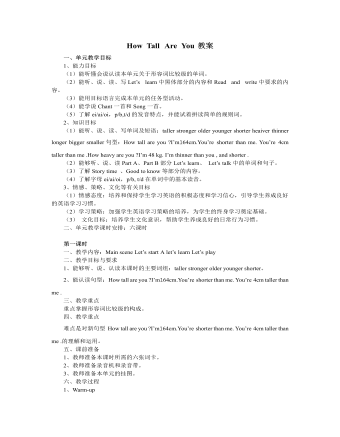
人教版新课标PEP小学英语六年级下册How Tall Are You教案
(1)呈现猴子图片,初步接触知识.教师在发指令时,加入 Touch your tail.当学生觉得茫然时,老师趁机出示课件(一只猴子)Look,We have no tails,but the monkey has.Look at the monkey,How long is the tail?在课件上呈现数据38cm.学生回答:Its tail is38cm long.根据教材内容教师提问:How tall is the monkey?学生:It’s 40cm tall.老师自己引出only一词,注意这个词的发音.多媒体再出示两只猴子的图片,一只黄色,一只棕色,让学生加以比较.教师问:Which monkey do you like?The yellow one or the brown one?【设计思路】 学生在回答这些问题时,也同时在复习前两课时所学内容,起到知识循环的作用.(2)猜一猜游戏:它们有多高?让学生猜一猜这两只猴子的身高.注意提示学生用上I think….这一句型,表示自己的猜测.在这里也可安排一个竞赛,看谁能猜中正确数据,教师让一些学生猜后出示数据.【设计思路】 学生对有悬念的东西都特别感兴趣,在此不仅练习了两位数的读法,又满足了学生的好胜心理.
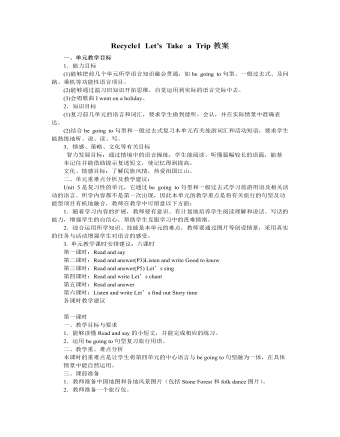
人教版新课标PEP小学英语六年级下册Recycle1 Let’s Take a Trip教案
4.巩固和扩展(Consolidation and extension) (1) 做本单元活动手册配套练习。 (2) 翻卡片说单词。学生两人一组,把单词卡片反面朝上放在桌子上,然后同时翻开两张单词卡(如:going, holiday),就马上组织成一句话(如:Where are you going on the holiday?/ I’m going to Kunming this holiday.),说得快又正确者为胜。 (3) 教师播放C部分Story time的录音或VCD,帮助学生理解故事内容。学生再听一遍录音,跟读故事里的句子,教师指导学生发音。 (4) Bright eyes. 在黑板上张贴Let’s find out的8幅图片,Mike, Zhang Peng, Sarah, Kathy等4个人物图片分别放在8幅图片上,如:Mike ---take pictures---buy presents。学生仔细观察后,请学生闭上眼睛,教师就趁学生闭眼之际交换人物位置(如把Mike放到eat noodles),然后请学生张开眼睛回答:What did Mike do just now ? 引导学生回答: Mike took pictures and bought presents. 教学参考资料库 1.文化背景介绍: 机场标志: Airport 飞机场 Airport lounges 机场休息室Airports shuttle 机场班车 Arrivals 进港Assistance 问讯处Check in area (zone) 办理登机区Departure airport 离港时间Departure times on reverse 返航时间 Welcome aboard 欢迎登机
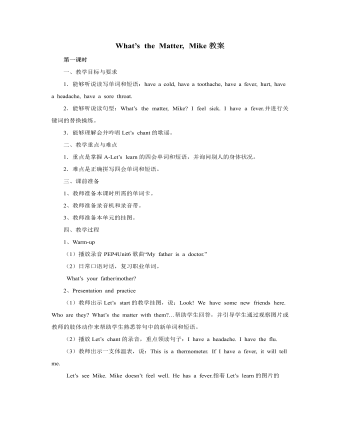
人教版新课标PEP小学英语六年级下册What’s the Matter, Mike教案
回答:She’s sad. She failed the math test.并板书:fail the math test。准备一张很糟的数学试卷,是学生了解语意。进一步教学其他短语a Chinese test, a English test,并 让学生了解pass the Chinese test, pass the English test, pass the math test. (4)教师请学生扮演Sarah,师生对话如下: T: Hello! Sarah, how are you? You look sad today. Sarah: Yes, I failed the math test. 教师接着说:I’m sorry to hear that.让学生理解意思。并引申出句子:I’m glad to hear that.让学生分角色朗读对话。 (5)Let’s check.让学生看Sarah的表情,并读两篇对话,选出正确的答案。 (6)活动名称:心理医生 活动目的:操练句型“How are you? You look…”.学生间自由组合编排对话.通过对话对学生展开情感教学,让学生理解健康的体魄和愉悦的心情的心情是一个人成功的重要因素,使学生形成良好的心理健康状态。 活动过程:A: How are you? You look bored today. B: Yes. I failed my math test. A: I’m sorry to hear that. Believe yourself. Work hard. You can pass the text next time. (7)活动名称:难忘时刻 活动目的:围绕照片上的表情展开询问和讨论.操练句型 “How do you feel? How does she/he feel?
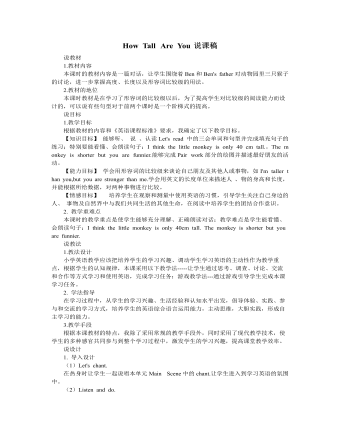
人教版新课标PEP小学英语六年级下册How Tall Are You说课稿
【设计思路】阅读最主要的目的是让学生看懂短文主要内容,通过上述判断题,可了解学生的掌握程度。(5)完成课文中的填空并校对。(6)学生听录音跟读,模仿录音中的语音语调。3.操练巩固请学生合作表演课文中的对话,课件出示情景和提示。这里也可进行分层次教学:有些学生擅长表演但语音语调在这节课上还没完全掌握,这里就可以请那些擅长表演的学生脱开课文表演,一部分学生可以与他人合作进行配音。【设计思路】 采用这个方式,可以照顾到程度不同的学生,参与面更广。本课时的阅读材料是动物间的比较,接下来我们要进行人物间的比较,让学生能更好地运用比较词和人称代词。这里可以采用游戏法和交际法。教师在屏幕上依次出现下列几组学生熟悉的人物:小丸子和蜡笔小新:王楠和张怡宁:贝克汉姆和欧文:樱木花道和流川枫。首先可以让学生猜一猜How old is he/she? How tall is he/she?Who is stronger/taller?Who is older/younger?等。

人教版新课标PEP小学英语六年级下册Last Weekend说课稿9篇
一、教学内容分析1. 教学内容介绍:.本课是一节复习课,复习内容为Last Weekend A B 两部分。教学主要是10个词组和2个句型,并结合六年级学生即将毕业,在原有教材的基础上融入了大量有关周末活动的句型和短语。使学生在“周末活动”这一话题下,尽可能多地滚动复习更多相关的动词短语。本课要掌握的短语和句子有Words and phrases: watched TV; washed clothes; cleaned the room; played football; visited grandparents; read a book; went to a park; went swimming; went hiking; went fishing;Key sentences: What did you do last weekend? I played football; Did you read books? Yes, I did. No, I didn’t.2. 知识的前后联系:Last weekend的话题是周末活动,关于日常活动的话题已在小学课本中多次出现,例如在B4U2; B5U2; B5U4; B6U1; B6U5; B7U3;B8U3中7次出现。在进行U3 last weekend的复习中,对周末活动的内容要进行深化。除了要求学生能够“四会”掌握本单元的词汇外,还应注意培养学生听、说、读、写的能力,让学生在一定的情景中在句中运用单词,在篇章中运用句子,赋予单词、句子特定的意义,而不是孤立地学习单词和句子,使学生一看到这些单词就能在一定的情景下使用,进而组合这些句子形成篇章,从而培养学生综合运用语言的能力。
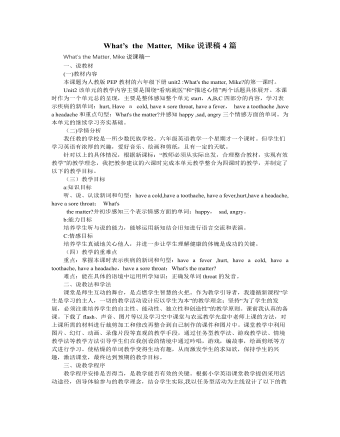
人教版新课标PEP小学英语六年级下册What’s the Matter, Mike说课稿4篇
请个别学生朗读、说出所缺字母并用肢体语言或表情说明意思。4.活动二:a guessing game利用卡片复习上节课的句型。[设计意图] 日常口语操练为学生营造了一个良好的学习氛围,英语歌曲优美动听,口语操练生动有趣,为学习新课打下了良好的基础.Step2Presentation (7 minutes) 活动三Learn the dialogue1.导看:教师用投影仪展示自己的一张旅游的照片和一张不及格的试卷,以此引出 词组a big trip, failed the math test.2.听对话录音,学生跟读。3.教师带读。4.两人一组分角色进行对话练习。5.分两大组朗读对话,对表现好的组予以表扬.6.师生就对话内容进行问答:T:Who looks happy? Why?S:Liu Yun looks happy. She is going on a big trip.T:Who looks sad? Why? S:Sarah looks sad. She failed the math test.[设计意图]使用实物展示来呈现新词组能加深学生对词组的理解和记忆.对于枯燥的句型朗读,采用多种不同的方式,如师生互动、分角色朗读,分组比赛等,避免学生产生疲劳感.

人教版新课标PEP小学英语六年级下册My Holiday说课稿5篇
本课时是本单元的第二课时,属对话课,它是对第一课时词汇课学习的一种巩固和延伸,同时也是下一课时阅读课的铺垫,因此起着承前启后的作用。二、学情分析通过三年多的英语学习,大部分学生已具备了一定的英语学习能力,他们能够听懂有关熟悉话题的语段,能与教师或同学就熟悉的话题交换信息,能读懂简短的的语篇。对于本文中的重点语法项目一般过去时,属于上一单元已学内容,本单元旨在继续巩固其用法,所以学生对该内容不是很陌生。三、教学方法及手段1.教学方法小学英语教学应该把培养学生的学习兴趣、调动学生学习英语的主动性作为教学重点,根据学生的认知规律,本课在应用任务型教学法的大前提下,利用情景教学法以及TPR教学法相结合,以学生为中心,以交际为主线,通过一系列的教学活动吸引学生的注意力,努力让学生积极参与,学以致用,并在用的过程中发展语言能力、思维能力以及交流合作的能力。

人教版新目标初中英语九年级下册By the time I got outside, the bus had already left教案
Ⅰ. Teaching Aims and Demands1. Knowledge Objects(1) Key Vocabularyoversleep(2) Target LanguageWhat happened?I overslept. And by the time I got up, my brother had already gotten in the shower.2. Ability Objects(1) Teach the students to use the new words.(2) Train the students to narrate past events with the Past Perfect Tense.(3) Train the students' listening and speaking skills with the target language.3. Moral ObjectIt’s a good habit to go to bed early in the evening and get up early in the morning. So you’ll never be in a hurry in the morning.Ⅱ. Teaching Key Points1. Key Vocabularyoversleep2. Target LanguageNarrate past events with the Past Perfect TenseⅢ. Teaching Difficult Points1. Train the students to narrate past events with the Past Perfect Tense.2. Train the students to understand the target language in spoken conversation.Ⅳ. Teaching Methods1. Thinking of examples from the students' real lives.2. Making sentences by looking at the pictures.Ⅴ. Teaching AidA tape recorderⅥ. Teaching ProceduresStep I Revision1. Revise the language points in Unit 8.Ask some questions like this: What volunteer work would you like to do?Help the students to answer, I’d like to…/I love to…/I hope to2. Practice the dialogue in Activity 3c on page 62 again. Get students to role play the similar dialogues with the following.

人教版新目标初中英语九年级下册Rainy days make me sad教案
1. 教材分析本单元以how do things affect you?为话题, 从颜色、天气、音乐、广告、产品等方面谈论了外界事物如何影响人的心情。要求学生掌握表达某物或某事给人带来的感觉、看法或影响等。共设计了四个部分的内容:Section A 该部分有4个模块:第一模块围绕Which restaurant would you like to go to?这一话题展开思维(1a)、听力(1b)、口语(1c)训练;第二模块围绕How does music affect you? 进行听力(2a-2b)、口语训练(2c);第三模块继续围绕how do colors in the restaurant affect you这一话题展开训练,训练形式为阅读和问题体验(3a)和小组活动(3b);第四模块仍就How do things affect you这一话题以调查的形式展开讨论。Section B该部分有4个模块:第一模块围绕产品广告对人们的影响这一话题以“配对”(1a)与“列举”(1b)两种形式展开训练;第二模块继续围绕How do things affect you? 进行听力(2a-2b)、口语对话训练(2c);第三模块围绕“Advertising”这一话题展开阅读(3a-3b)和写作(3c)训练;第四模块围绕How posters affect you这一话题以口语训练形式展开小组活动。

人教版新目标初中英语九年级下册Could you please tell me where the restrooms are教案
Step Ⅰ RevisionCheck homework. Ask a few students to read the article in 3a.Then ask a few students to read their guides.Step Ⅱ Part 1Look at the words in the box. Ask a student to read them. Make sure the students understand the meaning of the words. You are to fill in the blanks with the words. In some cases, students may need to use another form of the word, for example adjusting for tense or subject/ verb agreement.Ask students to fill in the blanks on their own.Check the answers. Step ⅢPart 2Go through the instructions with the class.Look at the example with the students.Ask students what the answer would be.Ask a student to read the question and answer it.Excuse me, could you tell me where the bank is, please?The bank is across the street from the shopping malt.Get students to complete the work in pairs.Check the answers. Ask a few students to read their questions.Step Ⅳ Just for Fun!Ask all the students to read the conversation. Ask: What is funny about this cartoon? Help students to explain. A Martian is a person from the planet Mars.There is no such thing as Martian food on Earth, and the clerk looks silly because he is trying to think of where there is a Martian restaurant.Invite some pairs of students to present this conversation to the rest of the class.Step Ⅴ Summary and HomeworkIn this class, we’ve done much writing practice using the key vocabulary words and the target language presented in this unit. After class, please finish the questions in 2 in your exercise books. Then finish the exercises on pages 47~48 of the workbook as well.The Seventh Period Ⅰ Teaching Aims and Demands1. Knowledge Objects(1) Key Vocabularyimage, adventure, jealousy, hero, crime, journey, brave, no longer, show interest in, take it easy, become interested in, plain looks(2)Text:Grown-ups like cartoons, too.2. Ability Objects(1) Fast-reading to get a general idea of the text.(2) Careful-reading to get the detailed information in the text.

人教版新目标初中英语九年级下册I’ll help clean up the city parks教案
Talk about offering help (P60)I’ll help clean up the city parks.A: I’d like to work ...B: You could help ...Talk about ways to tell people about the Clean-Up Day (P61)We need to ...We can’t ...I’ll ...Talk about the work the volunteers do (P62)These three students all volunteer their time to help other people.Somebody loves to ... / helps ... / plans to ... / wants to ...A: What do you like doing?B: I like ... A: What kind of volunteer work do you think I could do?B: You could ...1. 重点词汇advertisement, fix, repair, pleasure, blind, deaf, shut, carry, specially, fetch2. 认读词汇hunger, homeless, cheer, clean-up, sign, establish, major, commitment, elementary, veterinarian, coach, similar, call-in, strategy, disabled, organization, unable, support, appreciate, donation, part of speech, pronoun, adverb, preposition, conjunction, donate, Jimmy, Sally3. 词组clean up, cheer up, give out, put off, set up, think up, take after, fix up, give away, put up, hand out, work out, at once
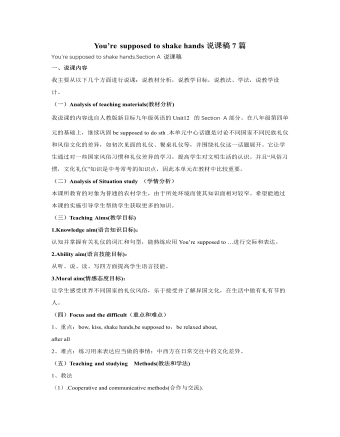
人教版新目标初中英语九年级下册You’re supposed to shake hands说课稿7篇
二 、教材分析本单元主要是通过对一些国家的风俗习惯、礼仪差异、时间观念和饮食文化的学习,进一步提高学生对文明生活的认识;加深学生对中外文化的了解,拓展学生的文化视野,为学生阅读相关方面的文章奠定一定的文化基础。我们知道近几年来有关风俗文化,生活习惯的 阅读内容一直是中考热门的话题之一。通过本单元的学习,学生可以掌握一定的相关方面的知识,为今后在阅读积累必要的信息。在Section A 当中出现的 be supposed to 句型为重点句型,此句型的语法结构为被动语态。被动语态也是历年来中考基础命题必考的内容之一。比如,去年的中考试题,在基础选择部分试题中就出现了对此语法结构考查。Section A 首先通过一些图片和句型来让学生初步了解本单元的语言目标。然后,通过练习进一步加以巩固。接着通过一组听力练习,来训练学生的听力,同时,学生可以具体了解到不同的国家在风俗习惯等方面有着怎样的不同。为下面的学习进行铺垫,同时激发学生了解更多的相关知识的学习兴趣。

人教版新目标初中英语九年级下册You’re supposed to shake hands教案
教学目标:1. 掌握本单元一些重点词汇的写法和用法。2. 学会自如谈论餐桌礼仪。Step 1 RevisionAsk some students to retell the customs at the table in France in the passage in 3a.Step 2 Self checkPart 1. Fill in each bland with the correct word given. Students do the exercises by themselves at first. Then check the answers. Ask the students to comprehend the sentences and help them point out uses of some words, like “arrive (at / in) sw., spend time / money on sth , spend time / money (in) doing sth.”Part 2. Read about Fan Ling’s experience in a western restaurant. Understand the passage. Point out some key points in the passage.1. be / get used to doing sth. 习惯做某事2. begin with = start with 以….开头3. crowd v. 挤满,塞满 the crowd 人群 crowded adj. 拥挤的Then students discuss about how she would solve her problem. Ask some to share their stories with others.Part 3. Complete the crossword by looking at the sentences on the left. Then check the answers.
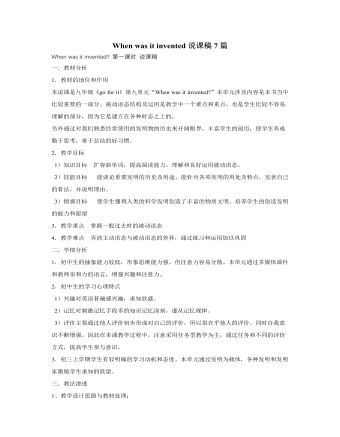
人教版新目标初中英语九年级下册When was it invented说课稿7篇
《新目标英语》中的具体语言目标是通过各种各样的Tasks来实现的;学生需要运用具体而特定的行动来完成一定的交际任务。整个教学过程中,各种语言结构与语言功能与不同的学习任务有机的结合。任务活动所谋求的效果不是一种机械的语言训练,而是侧重在执行任务中学生自我完成任务的能力和策略的培养;重视形式在完成任务过程中的参与和在交流活动中所获得的经验。因此本节课我将始终引导学生通过完成具体的任务活动来学习语言,让学生为了特定的学习目的去实施特定的语言行动,通过完成特定的交际任务来获得和积累相应的学习经验,让学生在用中学,在学中用。 2、教学原则 l 活动性原则 提倡学生主动参与,体验,交流,合作,探究等多种学习。 l 合作性原则 以学生为主体,师生合作,生生合作,体现教与学的互动,交往。 l 任务型原则 任务驱动—激发动机;任务完成—激励学习积极性;执行任务—培养责任 心和合作精神。 l 情感性原则 激发学生学习英语的兴趣和始终保持良好的学习情绪。